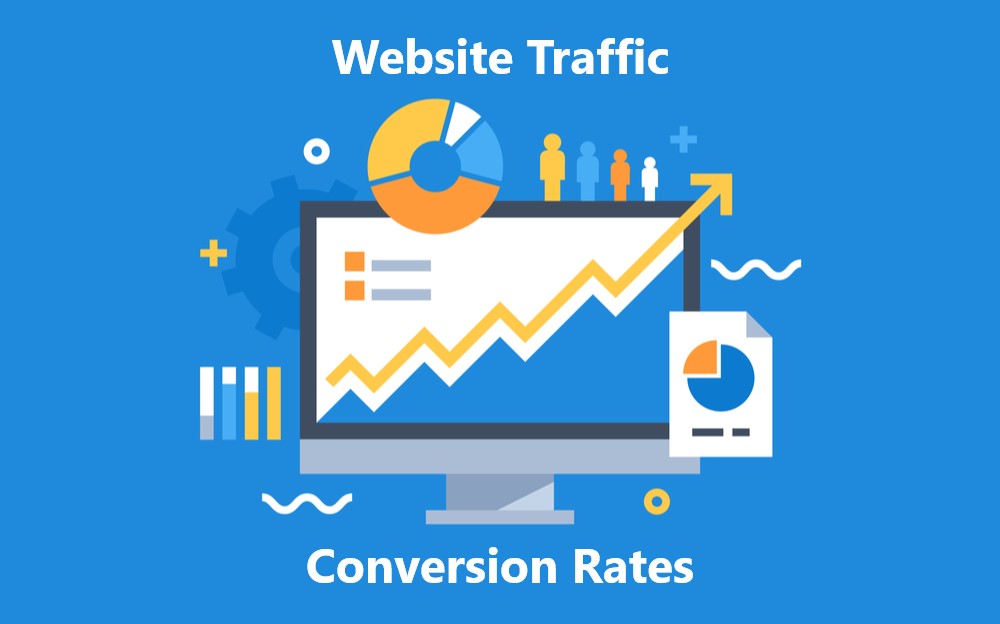In the digital age, attracting visitors to your website is only half the battle; the true challenge lies in converting those visitors into customers. Understanding the factors that influence Website Traffic and Conversion Rates is essential for any business looking to thrive online. This article explores key strategies to boost conversions, from optimizing user experience and leveraging A/B testing to improving site navigation and crafting compelling calls-to-action. By focusing on these critical areas, you can transform your website into a powerful tool for driving business growth and increasing your bottom line.
Understanding Website Traffic
Understanding website traffic is crucial for optimizing website performance and improving Website Traffic and Conversion Rates. Website traffic can be categorized into several types, each impacting overall site effectiveness differently.
Organic traffic comes from search engine results, driven by effective SEO strategies. This type of traffic is valuable because it indicates that your site ranks well for relevant keywords, often leading to higher conversion rates. Furthermore, organic traffic is typically more cost-effective over time, as it doesn’t require ongoing ad spend.
Direct traffic occurs when visitors type your URL directly into their browser. This usually indicates brand recognition and loyalty. Direct traffic is essential for measuring the effectiveness of offline marketing efforts or the strength of your brand.
Referral traffic comes from other websites linking to your content. It’s beneficial for increasing your site’s authority and attracting targeted visitors who are likely interested in your offerings. Referral traffic often leads to higher engagement, as visitors arrive with intent.
Paid traffic is generated from online advertisements, including pay-per-click (PPC) campaigns and display ads. Although it involves a financial investment, paid traffic can provide immediate visibility and targeted reach. This type of traffic is crucial for driving quick results, especially during promotional periods.
Each type of website traffic contributes differently to your overall site performance, and understanding these nuances is key to effectively managing Website Traffic and Conversion Rates.
Analyzing Traffic Sources
Analyzing traffic sources is essential for optimizing Website Traffic and Conversion Rates. Tools like Google Analytics provide valuable insights into where your traffic originates, enabling data-driven decisions.
Google Analytics tracks various traffic sources, including organic, direct, referral, and paid traffic. By monitoring these sources, you can determine which channels are most effective at driving visitors to your site. Understanding these traffic patterns allows you to allocate resources more efficiently, focusing on the most productive channels.
Moreover, Google Analytics provides detailed reports that help identify trends and patterns in user behavior. For example, you can see which referral sites bring the most engaged users or which keywords drive the highest conversions. This information is crucial for refining your SEO and content strategies.
Additionally, tracking traffic sources allows you to assess the effectiveness of marketing campaigns. By analyzing campaign-specific traffic, you can determine the return on investment (ROI) and adjust your strategies accordingly. This continuous optimization helps improve both traffic quality and conversion rates.
Ultimately, understanding and analyzing traffic sources is a vital step in enhancing Website Traffic and Conversion Rates. It empowers you to make informed decisions, ensuring your marketing efforts are both efficient and effective.
Improving Website Conversion Rates
Improving website conversion rates is crucial for maximizing the value of your website traffic. By implementing targeted strategies, you can significantly enhance both Website Traffic and Conversion Rates.
First, optimizing landing pages is essential. A well-designed landing page should be clear, concise, and focused on a single goal. Furthermore, using compelling headlines, engaging visuals, and relevant content can capture visitors’ attention and encourage them to take action. Simplifying forms and minimizing distractions can also lead to higher conversion rates.
In addition to landing page optimization, improving site navigation plays a key role in conversion rates. Easy-to-navigate websites allow users to find what they need quickly. Consider using clear menus, intuitive layouts, and strategic internal linking. These elements guide visitors through your site, increasing the likelihood of conversion.
Moreover, compelling calls-to-action (CTAs) are vital for driving conversions. CTAs should be prominent, persuasive, and aligned with the user’s intent. Action-oriented language like “Get Started” or “Claim Your Offer” can motivate visitors to act immediately. Testing different CTA placements and designs can help identify the most effective approach.
By focusing on these strategies, you can enhance your Website Traffic and Conversion Rates, turning more visitors into loyal customers.
A/B Testing for Better Conversions
A/B testing is a powerful tool for improving Website Traffic and Conversion Rates. By comparing two versions of a webpage or marketing element, you can identify which performs better in driving conversions.
Through A/B testing, you can test various elements such as headlines, images, calls-to-action, and page layouts. For instance, changing a headline or CTA button color can significantly impact conversion rates. By testing these variations, you gain insights into what resonates most with your audience.
Moreover, A/B testing allows you to make data-driven decisions rather than relying on assumptions. It provides concrete evidence of what works and what doesn’t. This approach ensures that your marketing strategies are optimized for maximum effectiveness.
Additionally, A/B testing can help you continually refine your website and campaigns. As visitor behavior changes, ongoing testing enables you to adapt and maintain high conversion rates. This iterative process is crucial for staying competitive and responsive to market trends.
In conclusion, A/B testing is essential for optimizing Website Traffic and Conversion Rates. It empowers you to fine-tune your strategies, ensuring that your website and marketing efforts are always aligned with your conversion goals.
The Role of User Experience (UX) in Conversions
User experience (UX) plays a critical role in Website Traffic and Conversion Rates. A well-designed website that offers an intuitive and seamless user experience encourages visitors to stay longer and engage more deeply with your content.
First, website design significantly impacts user experience. A clean, visually appealing design with easy navigation helps users find what they’re looking for quickly. Consistent branding, clear messaging, and responsive layouts enhance the overall experience, making it more likely that visitors will convert into customers.
Furthermore, load times are crucial for retaining traffic. Slow-loading pages frustrate users, leading to higher bounce rates and lower conversion rates. Optimizing images, leveraging browser caching, and minimizing code can improve load times. A faster site ensures that users remain engaged and move smoothly through the conversion funnel.
In addition, overall user experience extends beyond design and speed. It includes how visitors interact with the site, from the clarity of information to the ease of completing transactions. Simplifying the user journey, removing unnecessary steps, and ensuring that all elements work flawlessly on all devices can significantly boost conversions.
Ultimately, focusing on user experience is vital for improving Website Traffic and Conversion Rates. By prioritizing design, speed, and usability, you create a website that not only attracts visitors but also converts them into loyal customers.
Conclusion
In conclusion, optimizing Website Traffic and Conversion Rates is vital for turning visitors into loyal customers and driving business success. By focusing on key elements such as user experience, A/B testing, site navigation, and compelling calls-to-action, you can significantly enhance your website’s performance. Each strategy plays a crucial role in guiding visitors through the conversion funnel, ensuring that your website not only attracts traffic but also converts it effectively. Continuously refining these aspects will keep your website competitive, responsive to user needs, and aligned with your business goals, ultimately leading to sustained growth and profitability.


